Go the extra mile for your customers during this busy time, and a more positive CSAT score will be your well-deserved reward.
CSAT score is one of the main ways that customer support teams can measure their success. But what happens when it goes down? Your CSAT score can fall substantially during the holiday season, prompting many customer success managers to worry they’re failing their customers.
CSAT is based on a customer’s most recent interaction with your company. It records their immediate experience and how satisfied they are at a particular point in time. Since your score is not an overall reflection of how customers truly perceive your brand, it’s prone to extreme fluctuation—particularly during the holiday season.
To save your sanity this holiday season, keep reading for ten reasons your CSAT score may fall during this time of year, plus some suggestions for how to prevent or correct it.
 1. Increased volume of tickets
1. Increased volume of tickets
Sometimes it’s the sheer number of tickets you receive that can lead to problems in handling them. More purchases means more tickets. As a result, support tickets can increase by 42% over the holiday season.
In short, the increase means it’s easier to get things wrong. Your customers are typically ordering important items, and which they need to arrive by the same date as millions of other customers. This in itself is a huge logistical feat, and things often go awry.Furthermore, more tickets leads to longer call or email wait-times, with customers becoming more and more frustrated.
Review the volume of tickets you had in the same period last year. Did you see a spike over the holidays? If so, plan for it this time by provisioning more staff members to handle the influx. If you can’t hire more people, reduce the load for your staff by creating a holiday season FAQs to ensure that simple queries can be handled by self-service.
 2. More pressure to perform
2. More pressure to perform
US consumers spent three trillion US dollars in the retail industry over the 2013 holiday season, and online retail sales are predicted to rise 21% higher in 2018 compared to 2017.
When they’re spending so much money, customers have very high expectations of retailers during this time, and each brand is competing for limited attention. Your customers have chosen you over all the others so they expect to be rewarded.
Customer interactions levels are high from Black Friday all the way through to New Year. More exchanges and returns contribute to the busyness in customer support.
There’s more chance than usual of errors creeping in, and with the potential to result in more serious consequences. If you ruin someone’s surprise gift by sending them the wrong item, sending it late, or sending it broken, they’re going to be very upset with you.
When you make mistakes, admit it quickly and fix it. Make sure every team member understands your policy.
Due to the high volume of orders, it’s even more critical if you run out of stock. Pay close attention to stock levels, and have an action plan in place and a policy for if things go wrong.

3. Increased demand for staff
You may have to recruit extra customer service members during the holiday period to cope with demand. In fact, more than 768,000 new staff are recruited by companies each year. These staff members may not be as familiar with your processes, so they will not be as quick to deal with incoming tickets. Plus, your existing employees will also need to spend precious time training new staff.
Be sure you have a highly effective onboarding playbook to help you train new recruits, and ideally that your playbook has already been road-tested earlier in the year. Document your training process thoroughly as possible to set new hires up for a smooth transition onto the team.
 4. Longer wait times
4. Longer wait times
Customers hate long wait times, but their perception of how long they wait is what really drives customer satisfaction. Customers also hate uncertainty, so knowing how long they have to wait is essential. If you can’t avoid long waits, try to manage expectations by providing a rough estimate of how long it will be before customers can expect a response. Under-promise and over-deliver for happy customers.
Despite your best efforts, you may still end up understaffed. People get sick or go on holiday and fewer staff means fewer people to handle incoming tickets, and longer wait times for customers. Being low on staff in the short-term has massive after effects as tickets build up in queue, which makes it hard to catch up.
Avoid this happening by working out a holiday schedule, and decide what your coverage is over Christmas and New Year. Allow staff to work from home to minimize time spent traveling to the office.
 5. Yearly fluctuations
5. Yearly fluctuations
Customer satisfaction fluctuates year-on-year, which may affect how they perceive your brand. For example, in the American Customer Satisfaction Index, CSI went from a low of 73.0 in 2005 to a high of 77.0 in 2017. In between 2005 and 2017, CSI fluctuated between these two points. When CSI goes down, this pulls down the whole industry average.
This means that your CSAT score can fall through no fault of your own. Customers are just more unsatisfied with brands in general. You can offset this trend with proactive customer service.
For example, personalize their order with an unexpected handwritten note, or offer free delivery or a surprise product discount.
 7. Benchmark metrics
7. Benchmark metrics
CSAT score also differs by industry, and your score may dip due to the industry average. For example, customers may be particularly unhappy with retail in a given year, but very happy with the consultancy industry.
Depending on what sector or industry you’re operating in, you may actually be doing very well compared to other brands. Customer satisfaction scores are highest in IT & Consultancy, and lowest in Travel.
CSAT also varies by country, with US customers being the most extreme in their CSAT scoring (likely to rate high or low), while Japanese customers are most likely to give a rating in the middle.
 7. Seasonal marketing campaigns
7. Seasonal marketing campaigns
15% of US retailers begin their holiday season marketing campaigns on October 1, and it seems to be creeping earlier and earlier every year. Brands have to try harder and harder to differentiate themselves.
You might have promised your customers a limited edition product or service that differs from your usual offering. Departing from your usual types of products could lead to more mistakes made with orders, or the risk of not delivering on your promises
Offset potential problems by assigning dedicated team members to deal with your seasonal marketing campaign customers, and ensure they are treated like royalty.
 8. Customers are stressed
8. Customers are stressed
Your customers are already in a stressed-out mindset due to the time of year. This negative mood makes them more prone to rating your company interactions harshly.
Frazzled customers are more likely to make mistakes when ordering, and might change their minds about what they want. This has huge consequences, since 47% of customers leave a brand after just one bad instance of customer service. Customers also might take their frustration out on your staff, which lowers team morale.
Give your support staff lots of comfort breaks to help them recharge after difficult interactions. Schedule team rewards like outings and holiday bonuses to encourage staff to transmit positivity to your customers.
 9. More first-time customers
9. More first-time customers
Customers searching for the perfect gift in the run-up to the holidays, and you attract many new customers when they discover your brand. New customers have to learn your ordering system, and unique delivery and returns policies. They are more likely to make mistakes, or even just need to call your customer service team with a question.
If things don’t turn out as expected, it can lead to lower ratings when customers feel disappointed. They also judge you more harshly because you’re making a first impression.
Enhance your onboarding process for new customers so there are no nasty surprises. Study past tickets to find out where the pain points are, and make your delivery and returns policy explicit.
 10. Customers have low expectations
10. Customers have low expectations
The intensity of the holiday season means many customers already have low expectations for your support. They expect you to be busy already, and not able to help them. They are prepared to fight hard to get what they need, and this could lead to exaggerating problems just to get a response—leading to “revenge ratings”.
Sticky situations with customers are an opportunity for you to exceed their expectations. Peggy Emch from Timesheets recommends making it easy for your customers to self-serve.
Make sure your knowledge base is up-to-date and link to a schedule of your holiday opening hours. Consider also publishing a blog post for how to contact support during the holidays.
 Over to you!
Over to you!
A high CSAT score is not a goal in itself, but a way of evaluating how satisfied your customers are at any given time. Keep your score high by proactively countering these ten situations with preventative measures.
Watch out for staff burnout and reward your team for all their hard work. Go the extra mile for your customers during this busy time, and a more positive CSAT score will be your well-deserved reward.









